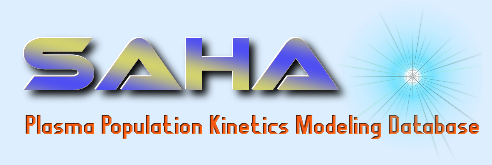
Version History - Disclaimer

|
HELP
|
Selection of Cases
The available cases are shown in the entry page. The present version of the SAHA
database includes results from the NLTE-3 Workshop [1,2] for steady-state calculations. Two links at the bottom of
this page provide links to important relevant information. First, a user can
access a list of codes and contributors. Second, a link to the Call
for Submissions that contains detailed information on cases, submission
formats, and other relevant issues.
Access to the database
There are two types of data access. The participants of the NLTE-3 Workshop are
granted an unlimited password-protected access. All other users can retrieve
exactly the same sets of data, and the only difference is that in this case the
code labels are hidden. This is done in line with the general agreement achieved
at the NLTE-3.
Selection of Parameters
The first output page provides the set of available parameters and options.
Plasma Parameters
Provides a list of available values of electron temperature and electron or ion
(for Xe) densities.
Global Parameters
These parameters describe the most general kinetic characteristics, namely:
- total number of ion stages
- total number of energy levels
- mean ion charge
- second central moment
- third central moment
- fourth central moment
- internal energy
- internal energy time derivative
- partition function
- maximal principal quantum number n
- total statistical weight for ion stage
A detailed description and units for these parameters can be found in the Call for Submissions section.
The global parameters are displayed for a selected range of temperatures or
densities. Therefore, a user has to select a corresponding X-axis (Te or
Ne).
Ion Parameters
This set describes parameters characterizing specific ion stages. Those are:
- total fractional ion population (sum of all ion populations is 1)
- maximal principal quantum number n
- total ionization rate (averaged over all levels within a specific ion stage)
- fractional collisional ionization rate (i.e., ratio of collisional to total ionization
rate)
- fractional photoionization rate
- fractional autoionization rate
- total recombination rate (averaged over all levels within a specific ion stage)
- fractional collisional recombination rate
- fractional photorecombination rate
- fractional dielectronic recombination rate
- total number of levels within a specific ion stage
- total statistical weight of all levels within a specific ion stage
- α/S ratio (i.e., ratio of total recombination to total ionization rates)
The output is generated as a function of the ion charge for a single pair of
Te/Ne values.
Spectrum
The Xe case also contains data on bound-bound, bound-free, free-free, and total
emission within the range of 9 to 120 Angstrom.
Java Plot Options
Database interface allows online generation of Java 2-D plots using the PtPlot
applet developed in the framework of the Ptolemy II project at the University of
California at Berkeley. The first output page provides options to (i) choose
whether or not to create the Java plot (default is create), and (ii) select
applet size in pixels.
Output Plot Axis Options
A number of output options are available for static plots:
- logarithmic scales for X- and Y-axes (applicable to Java plotting as well),
- minimum and maximum limits on X- and Y-axes,
- plot rescaling (normalization) so that the maximum parameter value is 1 for
each set of data,
- stack plot option allowing to create a separate plot for each set of data
rather than displaying all on one plot (only for static plots),
- use of absolute rather than relative values for process rates.
Output
The final output page contains a table of output parameters (both HTML and
ASCII), a Java PtPlot applet, and links to plots in different formats, namely,
Portable Network Graphics (PNG), Portable Data Format (PDF), PostScript (PS),
and Encapsulated PostScript (EPS).
Java Plot
A user may use a mouse pointer to zoom in and zoom out different areas on the plot.
There are four buttons in the upper right corner of the plot which provide
advanced control:
- print button -- shows print control panel,
- reset of the X- and Y-ranges to original values,
- plot format button,
- rescale button.
The "plot format" button allows user to modify plot title, X- and Y-labels, X-
and Y-ranges, grid appearance, connecting lines, color/BW switch, and also set
up user-defined ticks.
References
- Yu. Ralchenko, R. W. Lee, and C. Bowen, in: Proceedings of the 14th APS Topical
Conference on Atomic Processes in Plasmas, Santa Fe, NM (2004).
- C. Bowen, R. W. Lee, and Yu. Ralchenko, J. Quant. Spectr.
Rad. Tranf. 99, 102 (2006).



 Inquiries or comments:
Feedback
Inquiries or comments:
Feedback
Online: February 2006 - Last update: February 2006





 Inquiries or comments:
Feedback
Inquiries or comments:
Feedback